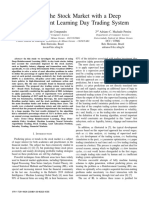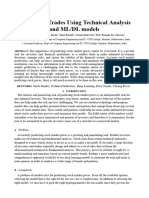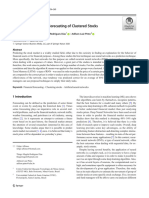0 ratings0% found this document useful (0 votes)
1 viewsA Multi-layer and Multi-Ensemble Stock Trader Using Deep Learning and Deep Reinforcement Learning - Anna’s Archive
This paper presents a multi-layer and multi-ensemble stock trading system that utilizes deep learning and deep reinforcement learning to enhance trading strategies. The proposed method processes stock price data through various neural networks and employs a meta-learner to maximize profits, demonstrating superior performance compared to traditional methods, including the Buy-and-Hold strategy. Experimental validation on real-world trading scenarios, including the S&P 500 and major stocks, confirms the effectiveness of the approach in generating robust trading decisions.
Uploaded by
Ivan MedićCopyright
© © All Rights Reserved
Available Formats
Download as PDF or read online on Scribd
0 ratings0% found this document useful (0 votes)
1 viewsA Multi-layer and Multi-Ensemble Stock Trader Using Deep Learning and Deep Reinforcement Learning - Anna’s Archive
This paper presents a multi-layer and multi-ensemble stock trading system that utilizes deep learning and deep reinforcement learning to enhance trading strategies. The proposed method processes stock price data through various neural networks and employs a meta-learner to maximize profits, demonstrating superior performance compared to traditional methods, including the Buy-and-Hold strategy. Experimental validation on real-world trading scenarios, including the S&P 500 and major stocks, confirms the effectiveness of the approach in generating robust trading decisions.
Uploaded by
Ivan MedićCopyright
© © All Rights Reserved
Available Formats
Download as PDF or read online on Scribd
You are on page 1/ 17
Applied Intetigence
https//dotorg/101007/10480.020-01839.5,
Check for
A multi-layer and multi-ensemble stock trader using deep learning _ “Pts
and deep reinforcement learning
Salvatore Carta’ - Andrea Corriga’ - Anselmo Ferreira" ® - Alessandro Sebastian Podda’ -
Diego Reforgiato Recupero!
(© Springer Sciences Business Media, LIC, part of Springer Nature 2020
Abstract
‘The adoption of computer-aided stock trading methods is gaining popularity in recent years, mainly because of their ability
{o process efficiently past information through machine learning to predict future market behavior. Several approaches have
been proposed to this task, with the most effective ones using fusion ofa pile of classifiers decisions to predict future stock
values. However, using prices information in single supervised classifiers has proven to lead to poor results, mainly because
‘market history is not enough to be an indicative of future market behavior. In this paper, We propose to tackle this issue by
proposing a multi-layer and multi-ensemble stock trader. Our method starts by pre-processing data with hundreds of deep
neural networks. Then, a reward-based classifier acts as a meta-learner to maximize profit and generate stock signals through
different iterations. Finally, several metalearner trading decisions are fused in order to got a more cobust trading strategy.
using several trading agents to take a final decision. We validate the effectiveness of the approach in a real-world trading
scenario, by extensively testing it on the Standard & Poor's 500 future market and the JL. Morgan and Microsoft stocks.
Experimental results show that the proposed method clearly outperforms all the considered baselines (which still performs
very well in the analysed period), and even the conventional Buy-and-Hold strategy. which replicates the market behaviour.
Keywords Deep learning - Deep reinforcement learning - Intraday stock trading
1 Introduction
‘The growing popularization of stock market trading has
become a rich field to be explored by powerful and
fast computing techniques. These tools have been widely
explored, to provide better trading strategies and to
maximize performance metries such as, among others,
profit, economic utility, or risk-adjusted return. Indeed,
‘machine learning solutions have been proposed to stock
trading even before the popularization of computers [15, 20,
21] and have potential to distribute wealth among investors
with a reduced need for human intervention,
“The research performod inthis paper bas been supported by the
“Hlando “Aiuth per progstt di Ricerca e Sviluppo"-POR FESR
2014-2020—Aste 1, Azione 1.1.3, Strategy 2- Program 3, Project
‘AlmostAnOracle~ Aland Big Data Algorithms fr Financial Time
Series Forecasting”
2 Salvatore Carta
salvatore@unicai
Extended author information available om the last page ofthe article,
Published online: 07 September 2020
Financial forecasting techniques are usually divided
into the branches of Technical Analysis (TA), which uses
data acquired from the past to indicate future behavior
of the market, and the Fundamentalist Analysis (FA),
Which analyzes economic metrics that may influence market
future trends. Machine-learning based TA approaches treat
stock market forecasting as a classification problem, where
classifiers use labeled time series data from historical prices
jn order to assign the following trading signals: a long
‘operation (ie., betting that the price will rise in the future)
‘or a short operation (Ze., to bet the opposite) should be
done in order to maximize the profit. Some solutions in
machine learning-based TA have been widely proposed in
the financial forecasting literature using, for example, deep
learning [24, 34], Support Vector Machines [7, 45], Random
Forests [18, 37], reinforcement learning [16, 23}, among
others. Although not the focus of this paper, both TA and FA
ccan be used together to perform financial trading [8, 17]
‘The computer-aided stock trading is basically composed
of two steps: (3) analysis of past market behavior, and
Gi) taking the optimal stock trading decision. To perform
such tasks, time-series data from past prices are usually
D springer
S.cartaetal
considered as input. These data are usually given by
the market under different resolutions (minutes, hours,
days, ete) and contain information such as open prices,
close prices, among others. However, such data contains
4 lot of uncertainty, specially because stock prices are
often influenced by other factors such as political events,
epidemics, performance of other markets and even the
behavior of other investors [4], These aspects model stock
‘markets as dynamic, non-linear, non-parametrie and chaotic
environments [36].
In order to minimize such issues in machine learning,
based trading, several solutions have proposed the fusion
of dozens of machine learning classifiers with the aim
to get more computer-aided stock traders involved in the
trading decision, which in tum minimizes the error of single
classifiers trained on insufficient data. These algorithms
luckle the no-free lunch theorem [41] by fusing several
‘weak classifiers decisions with low correlation in order 10
yield a strong final classifier. Inthe stock market forecasting,
Scenario, several literature approaches have been explored
in that sense, such as using boosting [42], late fusion
BI, dynamic ensembling [6], stacking [10], heterogeneous,
classifiers [28] among many others. Notwithstanding, such
supervised approaches still do not deal efficiently with raw
past prices data and their very known limitations. Therefore,
an efficient solution should be designed to better cope with
the uncertainty and, atthe same time, maximize ensembling,
steps in such a way to perform profitable and safer trading.
In this paper, We move towards tackling these issues.
by maximizing the performance of an ensemble based on
Reinforcement Leaming. Our stock trader is composed of
4 multi-layer and multi-ensemble classifier that acts in
three steps and use two ensembling techniques at the same
time. Our approach works by firstly applying several neural
networks in stock prices data in the first layer, and the
output will be used in a stacking ensembling technique in
the second layer. Then, the set of trading signals from the
neural networks are used as Features and a reinforcement
learning agent acts as a meta learner, maximizing rewards,
(profits) and yielding new trading signals through different
iterations. Finally, in the last layer of our trader, these new
signals are fused through another ensembling technique,
namely a majority voting (late fusion) approach, in order
to generate more robust final decisions. Simulations of
intraday trading on the Standard & Poor's 500 future market
and the J.P. Morgan and Microsoft stock markets show
that the proposed approach clearly outperforms not only
the conventional Buy-and-Hold strategy (and, consequently,
the market behaviour), but also several non-RL ensembling.
techniques and literature methods, which provide strong,
performance in the considered period.
D springer
In summary, the contributions of this paper are:
1, We propose a machine-tearning based stock trading
system composed by three different layers, that
leverages both on deep learning and deep reinforcement
learning benefits, which were proven to be effective in
several other machine learning fields [2, 43];
2. We exploit a novel pre-processing step based on
generating meta-features after converting price time-
series into Gramian Angular Field images [38], in order
to generate input data to be further processed in our
stacking ensembling approach;
3. We propose the use of a deep reinforcement leaning
meta-learner, which processes the trading signals from
Convolutional Neural Networks (CNNs) to generate the
final trading decisions:
4. We combine two different ensembling steps (stacking
in the second layer of our agent, and majority voting in
the last layer) to maximize the robustness and stability
of our trading strategy:
We evaluate our multilayer and multi-ensemble
approach in a real-world trading scenario, comparing
‘our experimental results with several baselines and Iit-
erature competitors, showing that it clearly outperforms
their performance,
‘The rest of this paper is organized as follows: in
Section 2, we discuss related work in. stock trading
using machine learning solutions. Section 3 motivates and
present our algorithm in details, Section 4 describes the
experimental setup considered to validate the proposed
approach, Section 5 shows experimental results and, finally,
‘Section 6 concludes this Work and discusses possible future
research directions motivated by the proposed method.
2 Background and related works
Several works in literature have been vastly proposed in
‘order to perform automated stock trading. One of the
pioneer works in this aspect is the work of Kimoto et al
[20], who used modular neural networks trained on various
technical and economical information in order to determine
when (0 buy and sell stocks. This work was extended
Fater in [15] using recurrent neural networks that are more
Suitable to time series. The work of Lee and Park [21]
used a similar recurrent neural network, but trained on
eleven economic indicators, Other subsequent works have
used more advanced machine learning classifiers to perform
stock trading. Sun et al. [34] used Long Short Term
‘Memories deep neural networks, an evolution of recurrent
networks, on augmented market trading data, The work of
You might also like
- A Novel Deep Reinforcement Learning Based Automated Stock Trading System Using Cascaded LSTM NetworksNo ratings yetA Novel Deep Reinforcement Learning Based Automated Stock Trading System Using Cascaded LSTM Networks11 pages
- Beating The Stock Market With A Deep Reinforcement Learning Day Trading SystemNo ratings yetBeating The Stock Market With A Deep Reinforcement Learning Day Trading System8 pages
- Stock Market Prediction Using CNN and LSTMNo ratings yetStock Market Prediction Using CNN and LSTM7 pages
- Deep Reinforcement Learning For Automated Stock Trading - An Ensemble StrategyNo ratings yetDeep Reinforcement Learning For Automated Stock Trading - An Ensemble Strategy9 pages
- Multi-Agent Q Learning Daily Trading 2007No ratings yetMulti-Agent Q Learning Daily Trading 200714 pages
- Deep Learning For Financial Time Series Forecasting in A-TraderNo ratings yetDeep Learning For Financial Time Series Forecasting in A-Trader8 pages
- Deep Robust Reinforcement Learning For Practical Algorithmic TradingNo ratings yetDeep Robust Reinforcement Learning For Practical Algorithmic Trading9 pages
- Deep Learning For Stock Market Trading: A Superior Trading Strategy?No ratings yetDeep Learning For Stock Market Trading: A Superior Trading Strategy?21 pages
- Deep Reinforcement Learning for Stock PredictionNo ratings yetDeep Reinforcement Learning for Stock Prediction6 pages
- Stock Trading Strategies Based On Deep Reinforcement LearningNo ratings yetStock Trading Strategies Based On Deep Reinforcement Learning15 pages
- Learning The Market - Sentiment-Based Ensemble Trading AgentsNo ratings yetLearning The Market - Sentiment-Based Ensemble Trading Agents10 pages
- Deep_Reinforcement_Learning_Robots_for_Algorithmic_Trading_Considering_Stock_Market_Conditions_and_U.S._Interest_RatesNo ratings yetDeep_Reinforcement_Learning_Robots_for_Algorithmic_Trading_Considering_Stock_Market_Conditions_and_U.S._Interest_Rates21 pages
- Applying Deep Learning To Enhance Momentum Trading Strategies in Stocks100% (1)Applying Deep Learning To Enhance Momentum Trading Strategies in Stocks5 pages
- C D L O B R L P T: Ombining EEP Earning On Rder Ooks With Einforcement Earning For Rofitable RadingNo ratings yetC D L O B R L P T: Ombining EEP Earning On Rder Ooks With Einforcement Earning For Rofitable Rading41 pages
- VC Comp Deep Reinforcement Learning AcceptedNo ratings yetVC Comp Deep Reinforcement Learning Accepted20 pages
- Self-Operating Stock Exchange: A Deep Reinforcement Learning ApproachNo ratings yetSelf-Operating Stock Exchange: A Deep Reinforcement Learning Approach16 pages
- A_Futures_Quantitative_Trading_Strategy_Based_on_a_Deep_Reinforcement_Learning_AlgorithmNo ratings yetA_Futures_Quantitative_Trading_Strategy_Based_on_a_Deep_Reinforcement_Learning_Algorithm5 pages
- A Deep Trend-Following Trading Strategy For Equity MarketsNo ratings yetA Deep Trend-Following Trading Strategy For Equity Markets27 pages
- Global Stock Market Prediction Based On Stock Chart Images Using Deep Q-NetworkNo ratings yetGlobal Stock Market Prediction Based On Stock Chart Images Using Deep Q-Network12 pages
- Paper_109-Day_Trading_Strategy_Based_on_Transformer_ModelNo ratings yetPaper_109-Day_Trading_Strategy_Based_on_Transformer_Model13 pages
- 1999Forecasting Series-based Stock Price Data UsingNo ratings yet1999Forecasting Series-based Stock Price Data Using6 pages
- Algorithmic Trading On Financial Time Series UsingNo ratings yetAlgorithmic Trading On Financial Time Series Using20 pages
- Topic 3 Deep Learning Based Feature Engineering For Stock Price Movement Prediction 20ptNo ratings yetTopic 3 Deep Learning Based Feature Engineering For Stock Price Movement Prediction 20pt4 pages
- Machine Learning For Algorithmic Trading: T KondratievaNo ratings yetMachine Learning For Algorithmic Trading: T Kondratieva5 pages
- Deep Reinforcement Learning Approach For Trading Automation in The Stock MarketNo ratings yetDeep Reinforcement Learning Approach For Trading Automation in The Stock Market10 pages
- Knowledge-Based Systems: Wen Long, Zhichen Lu, Lingxiao CuiNo ratings yetKnowledge-Based Systems: Wen Long, Zhichen Lu, Lingxiao Cui11 pages
- Forecasting Stock Prices From The Limit Order Book Using Convolutional Neural NetworksNo ratings yetForecasting Stock Prices From The Limit Order Book Using Convolutional Neural Networks6 pages
- Deep Reinforcement Learning For Algorithmic TradingNo ratings yetDeep Reinforcement Learning For Algorithmic Trading9 pages
- 10 DeepScalper A Risk-Aware Reinforcement Learning FrameworkNo ratings yet10 DeepScalper A Risk-Aware Reinforcement Learning Framework10 pages
- Trading Predictions Based On Neural NetworksNo ratings yetTrading Predictions Based On Neural Networks34 pages
- DLNN Based AT Strategy Using LOB and Tick DataNo ratings yetDLNN Based AT Strategy Using LOB and Tick Data105 pages
- Shortterm Stock Market Timing Prediction Under Reinforcement Learning SchemesNo ratings yetShortterm Stock Market Timing Prediction Under Reinforcement Learning Schemes8 pages
- 2007Short-term Stock Market Timing Prediction underNo ratings yet2007Short-term Stock Market Timing Prediction under8 pages
- Identifying Trades Using Technical Analysis and ML/DL ModelsNo ratings yetIdentifying Trades Using Technical Analysis and ML/DL Models14 pages
- Trend Prediction Classification For High Frequency Bitcoin Time Series With Deep LearningNo ratings yetTrend Prediction Classification For High Frequency Bitcoin Time Series With Deep Learning15 pages
- A Mean-VaR Based Deep Reinforcement Learning Framework For Practical Algorithmic TradingNo ratings yetA Mean-VaR Based Deep Reinforcement Learning Framework For Practical Algorithmic Trading14 pages
- 23-062_ed720ebc-ec4d-4bc3-a6ba-bad8cfbd9d51No ratings yet23-062_ed720ebc-ec4d-4bc3-a6ba-bad8cfbd9d5148 pages
- 23softcomputingstockmarketpricepredictionforthenigerianstockexchange-160803155349No ratings yet23softcomputingstockmarketpricepredictionforthenigerianstockexchange-1608031553495 pages
- 24-069_e5bcc300-d7f3-43b7-af9f-945b5937495eNo ratings yet24-069_e5bcc300-d7f3-43b7-af9f-945b5937495e63 pages
- A Novel Deep Reinforcement Learning Based Automated Stock Trading System Using Cascaded LSTM NetworksA Novel Deep Reinforcement Learning Based Automated Stock Trading System Using Cascaded LSTM Networks
- Beating The Stock Market With A Deep Reinforcement Learning Day Trading SystemBeating The Stock Market With A Deep Reinforcement Learning Day Trading System
- Deep Reinforcement Learning For Automated Stock Trading - An Ensemble StrategyDeep Reinforcement Learning For Automated Stock Trading - An Ensemble Strategy
- Deep Learning For Financial Time Series Forecasting in A-TraderDeep Learning For Financial Time Series Forecasting in A-Trader
- Deep Robust Reinforcement Learning For Practical Algorithmic TradingDeep Robust Reinforcement Learning For Practical Algorithmic Trading
- Deep Learning For Stock Market Trading: A Superior Trading Strategy?Deep Learning For Stock Market Trading: A Superior Trading Strategy?
- Stock Trading Strategies Based On Deep Reinforcement LearningStock Trading Strategies Based On Deep Reinforcement Learning
- Learning The Market - Sentiment-Based Ensemble Trading AgentsLearning The Market - Sentiment-Based Ensemble Trading Agents
- Deep_Reinforcement_Learning_Robots_for_Algorithmic_Trading_Considering_Stock_Market_Conditions_and_U.S._Interest_RatesDeep_Reinforcement_Learning_Robots_for_Algorithmic_Trading_Considering_Stock_Market_Conditions_and_U.S._Interest_Rates
- Applying Deep Learning To Enhance Momentum Trading Strategies in StocksApplying Deep Learning To Enhance Momentum Trading Strategies in Stocks
- C D L O B R L P T: Ombining EEP Earning On Rder Ooks With Einforcement Earning For Rofitable RadingC D L O B R L P T: Ombining EEP Earning On Rder Ooks With Einforcement Earning For Rofitable Rading
- Self-Operating Stock Exchange: A Deep Reinforcement Learning ApproachSelf-Operating Stock Exchange: A Deep Reinforcement Learning Approach
- A_Futures_Quantitative_Trading_Strategy_Based_on_a_Deep_Reinforcement_Learning_AlgorithmA_Futures_Quantitative_Trading_Strategy_Based_on_a_Deep_Reinforcement_Learning_Algorithm
- A Deep Trend-Following Trading Strategy For Equity MarketsA Deep Trend-Following Trading Strategy For Equity Markets
- Global Stock Market Prediction Based On Stock Chart Images Using Deep Q-NetworkGlobal Stock Market Prediction Based On Stock Chart Images Using Deep Q-Network
- Paper_109-Day_Trading_Strategy_Based_on_Transformer_ModelPaper_109-Day_Trading_Strategy_Based_on_Transformer_Model
- 1999Forecasting Series-based Stock Price Data Using1999Forecasting Series-based Stock Price Data Using
- Algorithmic Trading On Financial Time Series UsingAlgorithmic Trading On Financial Time Series Using
- Topic 3 Deep Learning Based Feature Engineering For Stock Price Movement Prediction 20ptTopic 3 Deep Learning Based Feature Engineering For Stock Price Movement Prediction 20pt
- Machine Learning For Algorithmic Trading: T KondratievaMachine Learning For Algorithmic Trading: T Kondratieva
- Deep Reinforcement Learning Approach For Trading Automation in The Stock MarketDeep Reinforcement Learning Approach For Trading Automation in The Stock Market
- Knowledge-Based Systems: Wen Long, Zhichen Lu, Lingxiao CuiKnowledge-Based Systems: Wen Long, Zhichen Lu, Lingxiao Cui
- Forecasting Stock Prices From The Limit Order Book Using Convolutional Neural NetworksForecasting Stock Prices From The Limit Order Book Using Convolutional Neural Networks
- Deep Reinforcement Learning For Algorithmic TradingDeep Reinforcement Learning For Algorithmic Trading
- 10 DeepScalper A Risk-Aware Reinforcement Learning Framework10 DeepScalper A Risk-Aware Reinforcement Learning Framework
- Shortterm Stock Market Timing Prediction Under Reinforcement Learning SchemesShortterm Stock Market Timing Prediction Under Reinforcement Learning Schemes
- 2007Short-term Stock Market Timing Prediction under2007Short-term Stock Market Timing Prediction under
- Identifying Trades Using Technical Analysis and ML/DL ModelsIdentifying Trades Using Technical Analysis and ML/DL Models
- Trend Prediction Classification For High Frequency Bitcoin Time Series With Deep LearningTrend Prediction Classification For High Frequency Bitcoin Time Series With Deep Learning
- A Mean-VaR Based Deep Reinforcement Learning Framework For Practical Algorithmic TradingA Mean-VaR Based Deep Reinforcement Learning Framework For Practical Algorithmic Trading
- 23softcomputingstockmarketpricepredictionforthenigerianstockexchange-16080315534923softcomputingstockmarketpricepredictionforthenigerianstockexchange-160803155349














































































